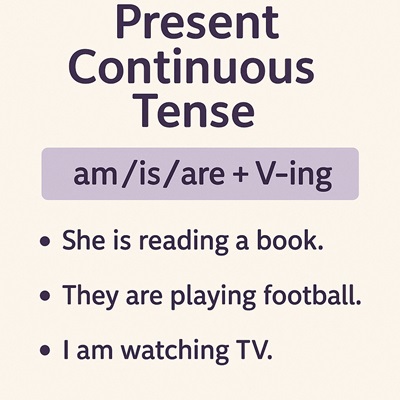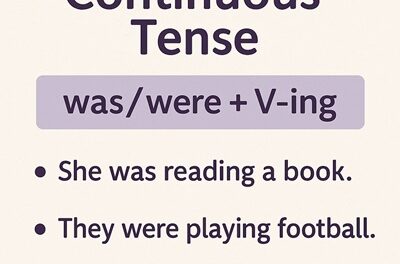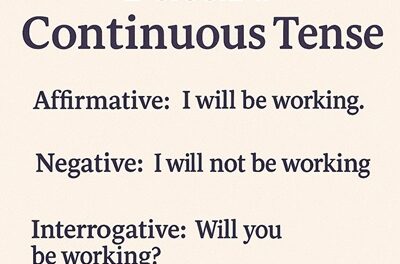Introduction to Present Continuous Tense
The Present Continuous Tense (also called the Present Progressive Tense) is used to describe actions that are happening right now or are ongoing. It is one of the most commonly used tenses in English.
Formation of Present Continuous Tense
The Present Continuous Tense is formed using: Subject + is/am/are + Verb (-ing) + Object
Examples:
- I am reading a book.
- She is cooking dinner.
- They are playing football in the park.
Uses of Present Continuous Tense
The Present Continuous Tense is used in various situations:
1. Actions Happening Right Now
We use this tense to talk about things that are happening at this very moment.
- The teacher is explaining a lesson.
- The birds are chirping outside.
- He is talking on the phone.
2. Temporary Actions
We use this tense for temporary situations that are not permanent.
- I am staying at my friend’s house for a week.
- She is working on a school project this month.
- They are living in London for the summer.
3. Future Plans (Near Future Intentions)
We use this tense for planned future events.
- I am visiting my grandmother tomorrow.
- They are going to a picnic next Saturday.
- She is meeting her friend at the mall in the evening.
4. Changing Situations
We use this tense for gradual changes.
- The weather is getting colder.
- He is becoming stronger day by day.
- The baby is learning to walk.
How to Make Sentences in Present Continuous Tense
1. Affirmative Sentences (Positive Sentences)
Structure: Subject + is/am/are + Verb (-ing) + Object
| Subject | Verb (-ing) | Object |
|---|---|---|
| I | am watching | TV |
| She | is reading | a book |
| We | are playing | football |
Examples:
- I am writing a letter.
- She is dancing beautifully.
- They are studying for the test.
2. Negative Sentences
Structure: Subject + is/am/are + NOT + Verb (-ing) + Object
Examples:
- I am not sleeping right now.
- He is not eating lunch.
- They are not watching the movie.
3. Interrogative Sentences (Questions)
Structure: Is/Am/Are + Subject + Verb (-ing) + Object?
Examples:
- Is she singing a song?
- Are they playing football?
- Am I doing it correctly?
Spelling Rules for -ing Form
To form the Present Continuous Tense, we add -ing to the base form of the verb. However, some spelling changes are required:
1. Regular Verbs:
- play → playing
- read → reading
2. Verbs Ending in -e:
Drop the final e before adding -ing.
- write → writing
- make → making
3. Verbs Ending in a Single Vowel + Consonant:
Double the last letter before adding -ing.
- run → running
- sit → sitting
Do’s and Don’ts of Present Continuous Tense
✅ Do’s:
✔ Use Present Continuous for actions happening right now.
- Example: “She is drawing a picture.” ✔ Use am, is, are correctly based on the subject.
- Example: “He is working hard.” ✔ Use the correct spelling for verbs ending in -ing.
- Example: “They are swimming in the pool.” ✔ Use Present Continuous for temporary or short-term actions.
- Example: “I am staying at my cousin’s house this week.”
❌ Don’ts:
✖ Don’t use stative verbs (verbs that express states, not actions) in Present Continuous.
- ❌ Incorrect: “She is knowing the answer.”
- ✅ Correct: “She knows the answer.”
✖ Don’t use Present Continuous for permanent situations.
- ❌ Incorrect: “He is working in a bank (permanent job).”
- ✅ Correct: “He works in a bank.”
✖ Don’t forget to use ‘not’ in negative sentences.
- ❌ Incorrect: “She is eating pizza. (when meant to say she isn’t)”
- ✅ Correct: “She is not eating pizza.”
Conclusion
The Present Continuous Tense helps us describe actions happening right now, temporary situations, and near-future plans. Remember to use is/am/are + verb (-ing) and avoid stative verbs. Practice regularly to master this tense and use it fluently in conversation and writing!

















